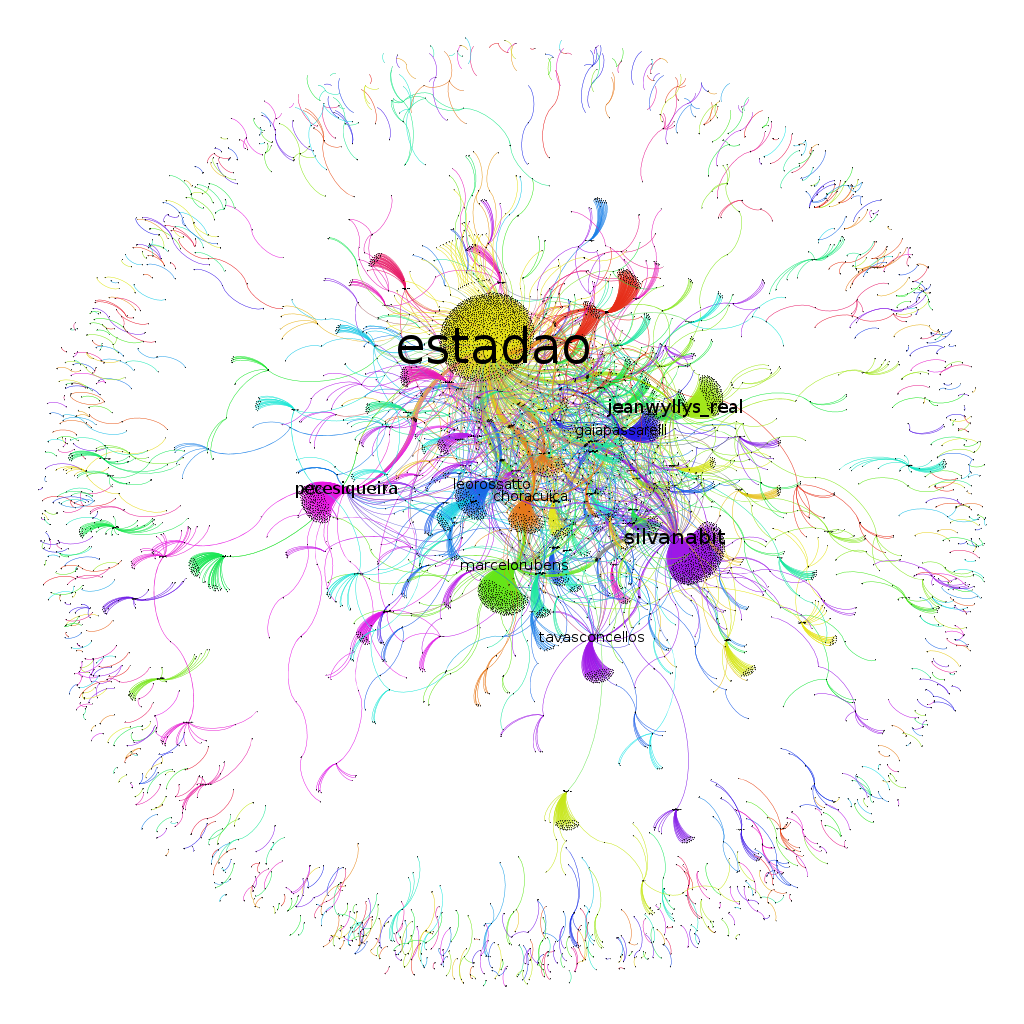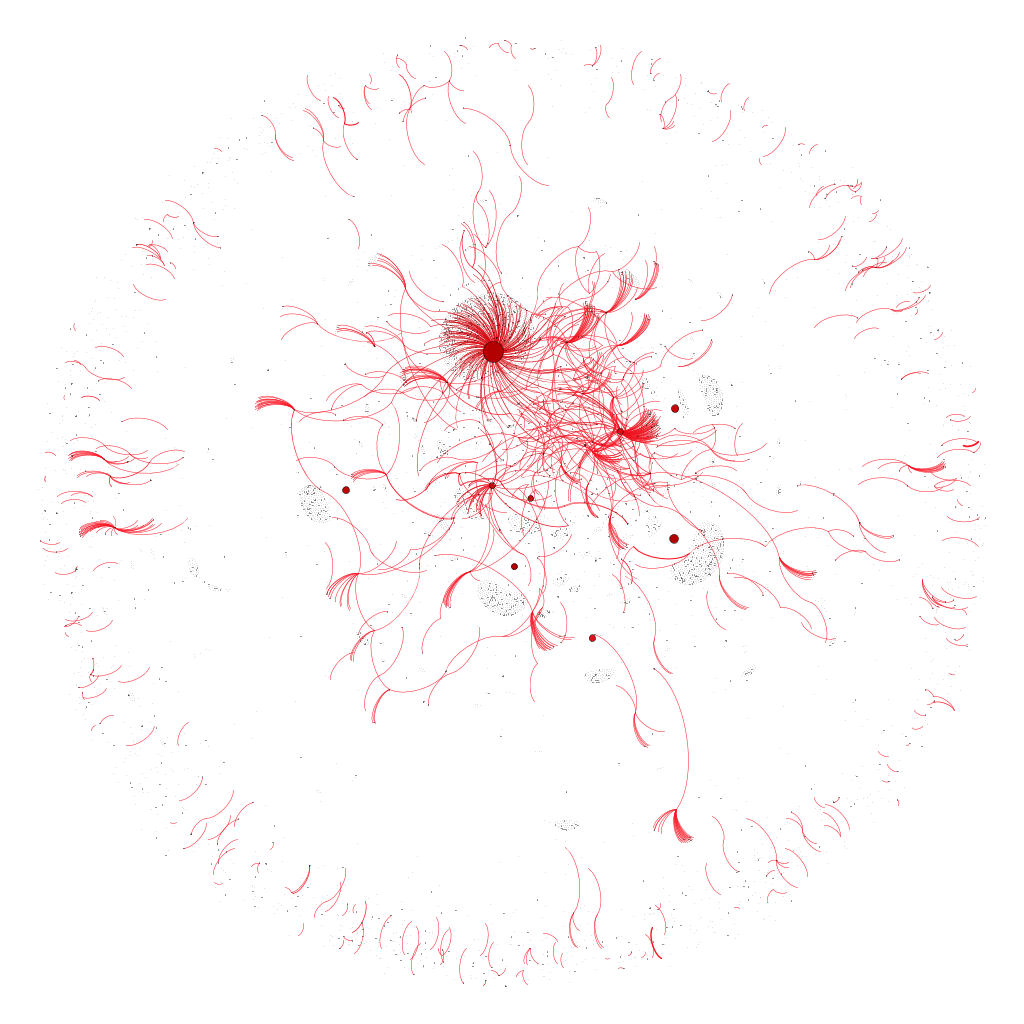English Translation: The Battle of Vinegar: Why #protestoSP had not one, but many hashtags
20 de junho de 2013 • por Labic
Author: Fabio Malini / Translation: Lorena Regattieri
I was puzzled by why a demonstration so intense – the struggle against rising bus fares in São Paulo – was called on the internet without the use of a hashtag. At first, the perception is that the movements in Brazil lean and articulate on Facebook, a website that became a model on social relationships in the country. It was at “Face” (abbreviation that brazilians gave to ‘facebook’) that the event “Great Third Act against rising bus fares” went viral: 28.000 profiles confirmed presence. Not profiles, people – even though there’s a legal association between both. A facebook profile is only a way to be a subject, as much as an individual also is. Among the 28.000 confirmed, obviously, there are numerous profiles of other states, something quite normal. To give strength to an event, the rule of conviviality at “faces” in Brazil is quite simple: I can not go, but I confirm presence. The dynamics of Facebook curiously illustrates the articulation between the streets and the internet. There are those who are present in the first and those who are present in the second. The firsts enunciate; Seconds advertise. The firsts, gathering inside the mobilization, reports. The second, from inside the network, spread the word and stir the emotions. The “Facebook event” is a kind of diversion embedded in the interface. The event is something that Facebook itself does not really know how to control (do you know where the Events area is located on Facebook’s interface?).
The event is the old discussion forum that has always agglutinated entire communities on the internet, even since 1979, when the Usenet came to public. Of course the dark side of this possible strength lies in the figures that “stalk” the forum to try to identify who are the “leaders”, who’ve called the movement, ie, who they must monitor. Unlike the old BBS’s or communities on Orkut, the “Facebook Event” has the horizon of disappearance. It happens. And once belonged to him, the profile can publish multimedia content of all kinds. In situations of intense protests, the event serves as a wall news for the struggles and a heterogenous construction of common narratives, which can be liked (popularized), followed (valued in terms of attention), commented (discussed and controversial turn in a public space) and the most radical action peer-to-peer, shared (disseminated by the profiles). In a very quickly analysis of the event called “Third Act” (it already turned into Act Four), a curiosity: the posts have, in general, more than two lines of text. What does this mean? That the profiles are emotionally engaged. There is not much room for a “Habermas rationality”, to theorize. There is only room for emotion n-1, that is, the emotion that derives from the effect of network nodes (n) crossing the profile (1).
Television mistakes and interactions on Twitter
But the channels n-1 are not reduced to Facebook. On Twitter, a curious effect occurred at the beginning of the demonstrations. Several profiles followed a live coverage of the old television media. And the profiles shared links from the live broadcast embedded at their websites, such as GloboNews and BandNews. Yesterday, TV stations, without knowing made a mistake. With their heads in the twentieth century, TV directors and editors broadcasted to a television audience, while the “embed” provided by the player from their websites helped the so-called “sofa activists” to narrate, in its raw state, the grotesque action from the Military Police at the Street Consolation. The expensive aerial imagery were on hands of the “confirmed on the internet, but not present in the streets.” The hacking made by the very structure of media that criminalized the movements (vandals, rioting, “aggressive people”, defamers), became fundamental to the fight against the “sofa reactionaries – which are paid profiles by the power to be discrediting the protests in the streets over the internet. Television, at that moment, being watched by teenagers and the elderly (the time from 18h to 19h is theirs) and the internet being occupied by ‘confirmed and the ones in the streets “and the “confirmed and the ones online.”

Datena (famous Brazilian TV presenter) is “surprised” with poll results beyond driven by the TV station. TV is being occupied by the second screen, the internet. (Photo by Jose Geraldo Couto, on facebook)
This disposition of a event without leaders proved to be the opposite of the #existeAmorEmSP (fantastic event against the neoconservative political system in São Paulo) – interpreted later as a movement sponsored by Haddad’s Administration. Now what I saw was a multiplicity of hashtags: #passelivre #contraoaumento #tarifazero #indignação #occupySP #protestoSP #13jSP. Different movements within the movement. This is called, in clear and simple language, masses. Treated as a crowd (in Negri’s political theory) these various movements do not called themselves this way. They call themselves the Masses, the real powerful lexicon brought from popular brazilian resistance. Enough of becoming! Let’s talk about Future itself! Enough with the multitude, let’s talk Masses!
The Masses on Twitter produced, between 5pm and 11h50pm, more than 17.000 tweets with the word “fare”. Instead of a hashtag, what heated up the discussions were the so-called keywords, words such as protest, journalist, bus, protesters, vinegar, bomb, anyway, the whole multiple universe, a rich vocabulary that explained the meanings prevalent in the Battle of Consolation, when Military Police have begun to trap the Masses who were at the demonstrations, using bombs, tear gas and shot rubber. As you can see, the interest in Google for the tag “bus fare” topped the Google Trends metric, taking into account the last 30 days.
I plotted the RT’s (retweets) network using the Yafan HU layout (which distributes nodes, seamlessly, from the size of the edges – or by the proximity of relationships, creating a central connection) and I also used the statistical filter Eigenvector Centrality, a way of calculating where the most central actors (located closer to the others) are, considering the entire network structure. Thus, when someone republishes the profile X, creates a relationship. When many others do the same operation, the profile X gains a foothold in the network space. . In practical terms, if a tweet is republished many times by journalistic profiles, they will be closer. The force that creates the political position is not derived from the profile, but how it’s appropriate by the whole network. “It is the other that creates the perspective.” The Eigenvector Centrality is a way to understand the position of a profile and its relationship with other areas of the network. The more relationships with other subnets, most of eigenvector centrality has, ie, more force attracts by him. A central node is the one who can attract an intensity of relationships. The ten profiles with this highest eigenvector centrality in conversation yesterday about the movement against rising bus fares were: @estadao, @silvanabit, @marcelorubens, @pecesiqueira, @jeanwyllis_real, @leorossatto, @choracuica, @gaiapassarelli, @g1 e @tavasconcellos.

RT’s network on Twitter. Profiles with high eigenvector centrality attract different relationships on Twitter, setting the predominant senses in the network against increasing bus fare from SP
Before the Police, after Police
Twitter profile @Estadao was one of the most attentive and active in the dissemination of the events happening in the streets, attracting many users to the whole network. Another profile, @SilvanaBit , drew a relational force largely because of a single tweet, which was republished 706 times: “Six reporters from a single newspaper injured in a demonstration against the bus fare. Neither among war correspondents that happens “. Writer @marcelorubens had republications from different nodes attached to the network topology, stating that the beating promoted by the Military Police caused the protest to become something much broader than the fare bus issue.”These protests are not just an attempt to lower the bus fare tickets, but also against the violence which the State treats the citizen, without addressing the violence itself.” Blogger @pecesiqueira (widely read among teenagers) ironically joked with the arrest of a journalist porting vinegar. “Vinegar a FUCKING DANGEROUS WEAPON RT @Estadao SP: Carta Capital’s journalist was arrested in demonstrations with vinegar http://migre.me/f0rLF .”
Deputy Jean Wyllis was attentive to the online conversation, making sure to disqualify (especially those sections of the media) who tried to associate the protesters to labels like angry, aggressive and criminal. He took action to qualify the political cause, and just like @Estadao, he was watching the demonstrations, carefylly observing the information flow of what was reported by activists in the streets and online press. His tweet that attracted different networks was a criticism of the declaration given by MIlitary Police to @Estadai: “RT @ jeanwyllys_real: Go kill?! RT “@Estadao PM: The situation is out of control: ‘We are not responsible for what happens over’ http://migre.me/f0uqZ”.
One of the most interesting elements of the impact of street demonstrations on the network will be the emergence of profiles that do not have high popularity on the Internet (called poor nodes), but with the ability to say something that spreads on the network, they’re able to build a perspective of many (without thereby revert this to increase followers and popularity for the author of the original message). @LeoRossatto is such a case, once he tweeted “The bus fare turned into the smallest of issues now. The next demonstrations must be, above all, about the freedom to protest.” he saw his message gain airs of slogan due to a statement that many would like to have made at that moment in the history of this narrative (when the aggressive police reaction happened). It was the same with @choracuica, who tweeted (being retweeted 190 times): “it’s not just about the bus fare anymore. fuck the rate. it was much more than the matter of the fare”. And it’s also with the message from @gaiapassarelli: “there is something big happening and is less about fare increase and more about take a stand. everyone should pay attention.” Still with this tweet from @tavasconcellos: “it’s no longer a discussion on fares. transportation. rioting. about any of this. is about the right to speak for any cause.”
These four tweets, together, are the most retweet messages on Twitter (almost 1000 retweets). It illustrates, from a political point of view, that the state of outrage had expanded and that the movement would unfold in different marches and actions, already evident, with the call for the March of Vinegar (Saturday) and ‘Act 5’ against increases in transportation fares (due to next monday). Alckmin Fernando Haddad and tendon are seen the same perspective and no longer counts with the hegemonic view that the protest is violent people and thing “that hates and loves.” The bipolarity tucana x PT became a blocão way that pushes both to the same place: the power elite of São Paulo. Much of this was caused by the action of truculent PM, as we see, to analyze the network’s temporal movement. At first the movement was shy on the network. And won ballast with the moment of “thrills” with the police. Geraldo Alckmin and Fernando Haddad are seen as having the same perspective on the demonstrations and no longer have the hegemonic view spread around the population that the protests are made up of violent people “full of hate and no capacity to love”. The bipolarity PSDB x PT became a miscelany of senses that pushes, both of them, to the same place: to the powerful elite of São Paulo. Much of this was caused by the MIlitary Police truculent action, as we can see, when we analyze the demonstration’s temmporal network. At first the protest was shy on the internet. And won ballast with the moment of “thrills” with the police. And won ballast to the timing of “thrills” with the police.
To plot the temporal network, what did I do? I exported the csv file with the tweets that possessed the tag “rate” (although the movement has been much larger on Twitter, because, as I said, the profiles published several information without the hashtag and without using the word rate). In my dataset, we gathered almost 20,000 tweets with the word rate. I ran the file in R and IGRAPH, separating the graph file (GraphML) RTs and ATs (mentions). The scriptR we use brings rt.time (the time of publication of the tweet). Then I plotted the file rt.graphml in Gephi to visualize the network. Once I had a network I used a plugin called Gephi Streaming to out the network in a chronological order. The result is impressive. Before the police action heated up the network, the focus was on reporting the march. After the police action, the network totally heated up. This guided countless conversation in many profiles, making the fact even more public. And so the pressure on public administrators grew.
As you can see:
Then there is a conflict of sectors of the police with the protestors, at the beginning of Street Consolação. Confrontation begins and the network’s temperature rises:
I tried to do something fast about how the street is able to feed the internet, in this case Twitter, with reports and messages that gain vastness due to the cooperative work of twitter profiles that a assume behavior tuned to the facts occurring in the streets, tweeting from the streets itself and from the internet. This was the first article. The work must continue.
PS: This paper had the cooperation of professors Raquel Recuero and Marco Toledo.



Comentários